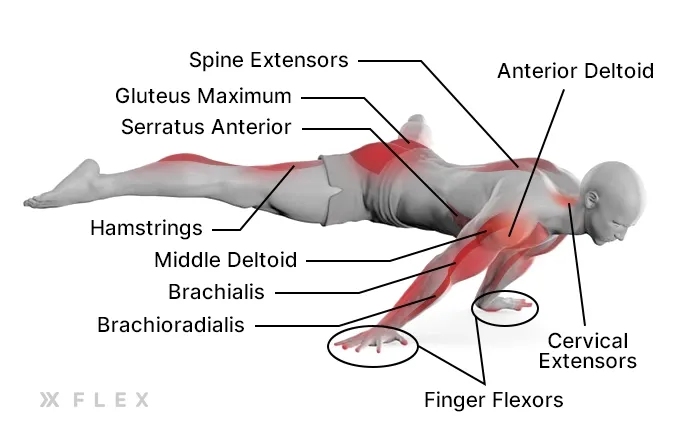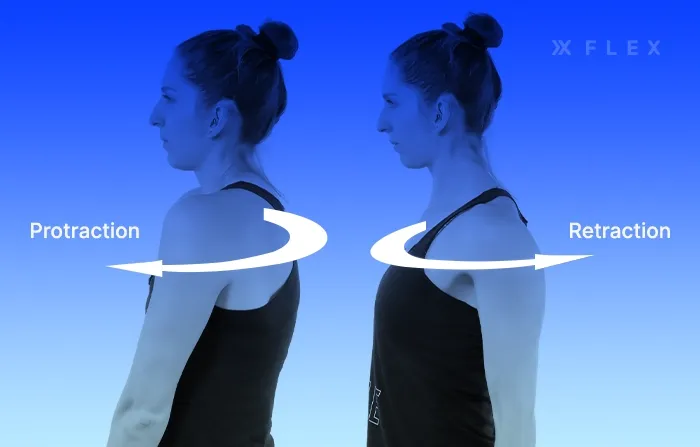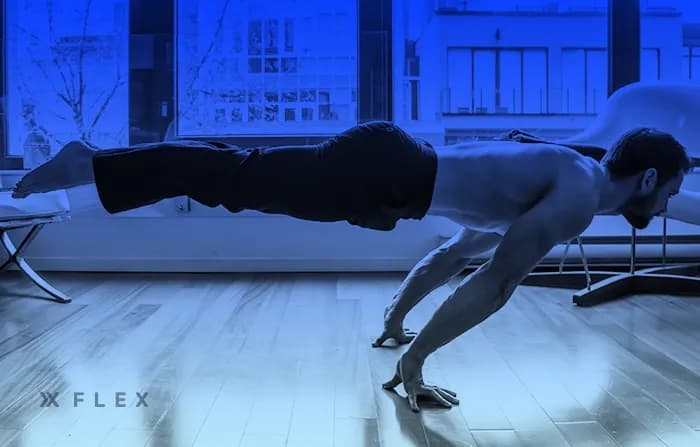Planche Progression: Elevate Your Calisthenics Technique
This is a calisthenics movement guide. Learn how to work on planche progressions to train towards a full planche.
This is pretty much the apex of all calisthenics moves.
Being able to write “planche master” down on your resume officially relegates you to top-dog status.
But how do you get there?
In this article, we’ll break down one of the most advanced calisthenics moves you can learn: the full planche.
Let’s walk through what goes on in your body when you do a planche.
Plus, find out what progressions to try to work up to this high-skilled bodyweight-only move.
Why Is the Planche Progression Important?
You may be thinking: “Why should I follow a planche progression?
For calisthenics newbies especially, you may find yourself longing to go from point A to point Z.
Watching endless YouTube tutorials or seeing high-level calisthenics athletes on TikTok can inspire you to want to be the best right away.
After all, calisthenics is one of the more challenging forms of physical activity, even for strength-trained athletes. Several moves target pretty much all the muscles of the human body. This includes small muscles and big muscles alike.
That being said, working through progressions helps you attain muscular mastery. When you’ve put in time and effort at each level of a progression, you take the time to feel the muscles at work in every part of your body.
Sometimes we can “crank” or overextend the body into positions it’s not ready for.
Yes, TECHnically you’re getting there, but if a move A) isn’t repeatable with perfect form every time and B) doesn’t allow you to find comfort or flow, it’s a bit disingenuous to say that you’ve nailed it.
For example, if you can “do” 20 pull-ups, but not one rep is at full form, people may call you out for sloppy technique! And you’re doing yourself a disservice by not working through your full strength to improve.
What Muscles Does a Planche Work?
The full planche and planche progressions work several muscle groups, mostly in your upper body. Most of your work is concentrated in:
Deltoids
These shoulder muscles help you stabilize your shoulders and move your arms.
Pectoralis Major
Your chest muscles help you move your shoulders and pull your arms across your body.
Biceps
These inner-arm muscles help flex your elbows and rotate your arms.
Triceps
These muscles on the backs of your arms help you extend your elbows.
Abdominals
The abs, including your Rectus abdominis, (aka six-pack)keep your organs and spine stable. These muscles help your posture and balance and connect your upper and lower body. Reducing abdominal fat is one of the best ways to keep your organs healthy and lessen your risk of disease.
Since the planche is a total body move, it also hits leg muscles like the glutes, hamstrings, and quads to keep you stable.
Here, you are also putting all of your weight into your hands, so your wrists are hard at work too.
Pro-tip: focus on grip training or wrist-strengthening exercises if you are training a planche. You may want to do simple wrist rolls as a warm-up or practice dead hangs from a bar to get comfortable coordinating wrist strength and body weight.

There are many benefits to planche training. Not only do you hit major muscles of the body like your upper arms and core, and large muscles like the external obliques, the planche can help strengthen your shoulder joints.
It may even help you with weight loss. By working your muscle fibers when your muscles contract, you can build significant strength in your planche and potentially lose weight.
Now that we understand which muscles are at work, let’s break down some progressions you can use to get into a planche. Remember to warm up before you try these moves. Calisthenics exercises can put your body in very different positions than you may be used to from weightlifting.
Although some research indicates that weightlifting may have a higher impact on body fat reduction than bodyweight exercise, calisthenics is a great way to build functional strength and flexibility. That being said, be careful not to get injured, especially when you’re starting out. These weight-bearing moves can be a lot on your joints.
Knee Planche Push-Up
Like in a traditional push-up, you can work up to planche push-ups on your knees.
For this version of a planche, come to a high plank position on your knees, instead of your feet. Rotate your hands outward, anywhere from 45 to 90 degrees, depending on your comfort.
Lean forward so your shoulders are extended in front of your hands. This is different than a traditional push-up, where your shoulders track above your hands. The planche hand placement puts more pressure on your triceps. This can take some getting used to.
From the knees, bend through your elbows and lower yourself down into a push-up, keeping your elbows tracking backward as you bend.
Keep going for as many reps as you need. Once you’re comfortable with a kneeling variation, try going for sets, or even just getting comfortable with a few reps on your toes.
Let’s break down the next step: the pseudo-planche push-up.
Pseudo Planche Push-Up Progression
The pseudo planche pushup progression is a great way to better understand the hand placement you’ll need in a full planche, tuck planche push-up, or even a full planche push-up.
To try this variation, come to a high plank. Again, externally rotate your hands like in the kneeling planche variation anywhere from 45 to 90 degrees.
Bring your body forward so your shoulders extend beyond your hands.
Using your strength, bend the elbows and lower your body down into a push-up. Don’t let your elbows splay out to the sides. Perform as many reps of this exercise as you need.
At this stage or if the push-up feels like too much of a challenge, try a pseudo planche lean: simply get your body into the same starting position, but instead of pushing up, just lean the weight into your hands and get comfortable here.
For those of us with weaker wrists, even this can be a lot. It’s a great step to start challenging your body and building your strength.
Minus the Gym— Here, we see a pseudo planche push-up. This is one of the most useful techniques for mastering the hand placement for a full planche.
Tuck Planche Progression
@c_raytrains demonstrates a few moves you can use to work up to a tuck planche progression.
The tuck planche progression is one of the best early milestones to learning a full planche. Not only is it challenging, but it can feel great to master this move all by itself, even before working to extend your legs.
Working up to tricky bodyweight movements can be a great way to build not only strength but confidence.
Get familiar with the tuck planche progression step by step.
For a tuck planche, you’ll start rounding out your spine to contract your abdominal muscles and protract your shoulder blades (push them out to the sides). This feeling of protraction and deeply engaging your core will help you feel the sensation that you should be getting once you work up to a full planche.
Tuck your knees into your chest tightly, and bring yourself into a low squat position. Push into the floor as hard as you can with your hands, leaning your body forward.
Keep extending until your shoulders move past your hands, bringing you out of your squat so that just your toes graze the floor. Eventually, you will be able to push so far forward that your toes float off the ground.
Full Planche
For a full planche, you’ll need to have mastered the variations leading up to the movement.
Once you’re comfortable with pseudo planche push-ups and pseudo planche leans, you can start to elevate your feet into a full planche.
From a high plank position protract your shoulders by pushing your shoulder blades sideways and forwards. Think about your back expanding here and taking on a slight curve. Engage your core as you do this.
Like in the earlier progressions, plant your hands on the ground and externally rotate your arms. Spread your fingers and think about clawing them down into the ground.
Wide fingers give you a wider base so there is more of a surface supporting this balance pose once you bring your legs up.
Lean into the hands, keeping the core engaged and shoulders protracted. Come forward so your shoulders are tracking in front of your hands. Eventually, you will lean so far forward that you can begin to lift your feet off the ground. Keep your legs straight and focus on your range of motion. Make sure to keep straight arms in this move too.
Once you’ve leaned as far as you can, play around with lifting your feet. See if you can get one leg up, or try a short hold if you manage to get both feet off the ground. Don’t think of this as a lower body move, but instead as one that comes from the shoulders, upper body, and core.
Once you lean far enough forward, your legs will have no choice but to lift since there’s nowhere further to go!

Pro tip: Use parallettes if you prefer them to flat hands on the floor to enhance your planche workout. You can also try these handles for other moves like handstands.
Calisthenics expert Chris Heria demonstrates a full planche, plus some progressions you can use to work up to this move.
Big Picture
Starting “small” (none of these moves are really small, we think they’re all guaranteed to challenge you, depending on where you’re at on your calisthenics journey) is the best way to increase your planche progression.
Always make sure to warm up your wrists and shoulders before trying any planche progression. This is an intense bodyweight move. If you’re used to weightlifting, the body positions used in calisthenics can be unfamiliar for you, putting you at a higher risk of injury. For more calisthenics information, learn about moves like the muscle-up.
If you’re wondering whether weights vs. bodyweight is the superior option, test out your push-ups vs. bench press to see which you prefer.
If push-ups are your preference, try NFL star Herschel Walker’s 1,000+ push-up routine to test your mettle.
Shoot for progress, no matter which workouts you’re doing. Flex AI offers an all-in-one workout platform to help you learn new exercises, visualize your fitness journey and keep all your PRs in one place.
We’ve made it simple to work on customized fitness plans or to introduce a little friendly competition to your fitness community by sharing exercises with your friends. Try it for free through the Flex fitness app.
References
Elzanie A, Varacallo M. Anatomy, Shoulder and Upper Limb, Deltoid Muscle. [Updated 2023 May 8]. In: StatPearls [Internet]. Treasure Island (FL): StatPearls Publishing; 2023 Jan-. Available from: https://www.ncbi.nlm.nih.gov/books/NBK537056/
Tiwana MS, Charlick M, Varacallo M. Anatomy, Shoulder and Upper Limb, Biceps Muscle. [Updated 2023 Aug 28]. In: StatPearls [Internet]. Treasure Island (FL): StatPearls Publishing; 2023 Jan-. Available from: https://www.ncbi.nlm.nih.gov/books/NBK519538/
Tiwana MS, Sinkler MA, Bordoni B. Anatomy, Shoulder and Upper Limb, Triceps Muscle. [Updated 2023 Aug 28]. In: StatPearls [Internet]. Treasure Island (FL): StatPearls Publishing; 2023 Jan-. Available from: https://www.ncbi.nlm.nih.gov/books/NBK536996/
Vispute, S. S., Smith, J. D., LeCheminant, J. D., & Hurley, K. S. (2011). The effect of abdominal exercise on abdominal fat. Journal of strength and conditioning research, 25(9), 2559–2564. https://doi.org/10.1519/JSC.0b013e3181fb4a46
Wei, W., Zhu, J., Ren, S., Jan, Y. K., Zhang, W., Su, R., & He, L. (2023). Effects of progressive body-weight versus barbell back squat training on strength, hypertrophy and body fat among sedentary young women. Scientific reports, 13(1), 13505. https://doi.org/10.1038/s41598-023-40319-x
Related articles


Get fit with Flex
Build muscle & lose weight fast for free.
Available on iPhone + Apple Watch





